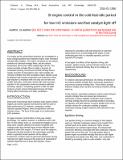| dc.contributor.author | Cedrone, Kevin | |
| dc.contributor.author | Cheng, Wai K. | |
| dc.date.accessioned | 2015-08-07T12:21:06Z | |
| dc.date.available | 2015-08-07T12:21:06Z | |
| dc.date.issued | 2014-04 | |
| dc.identifier.issn | 1946-3944 | |
| dc.identifier.issn | 1946-3936 | |
| dc.identifier.uri | http://hdl.handle.net/1721.1/98046 | |
| dc.description.abstract | The engine and its exhaust flow behaviors are investigated in a turbo-charged gasoline direct injection engine under simulated cold-fast-idle condition. The metrics of interest are the exhaust sensible and chemical enthalpy flows, and the exhaust temperature, all of which affect catalyst light off time. The exhaust sensible enthalpy flow is mainly a function of combustion phasing; the exhaust chemical enthalpy flow is mainly a function of equivalence ratio. High sensible and chemical enthalpy flow with acceptable engine stability could be obtained with retarded combustion and enrichment. When split injection is employed with one early and one later and smaller fuel pulse, combustion retards with early secondary injection in the compression stroke but advances with late secondary injection. Comparing gasoline to E85, the latter produces a lower exhaust temperature because of charge cooling effect and because of a faster combustion. | en_US |
| dc.description.sponsorship | Borg-Warner Corporation | en_US |
| dc.description.sponsorship | Chrysler Corporation | en_US |
| dc.description.sponsorship | Ford Motor Company | en_US |
| dc.description.sponsorship | General Motors Corporation | en_US |
| dc.language.iso | en_US | |
| dc.publisher | SAE International | en_US |
| dc.relation.isversionof | http://dx.doi.org/10.4271/2014-01-1366 | en_US |
| dc.rights | Creative Commons Attribution-Noncommercial-Share Alike | en_US |
| dc.rights.uri | http://creativecommons.org/licenses/by-nc-sa/4.0/ | en_US |
| dc.source | Prof. Cheng via Angie Locknar | en_US |
| dc.title | SI Engine Control in the Cold-Fast-Idle Period for Low HC Emissions and Fast Catalyst Light Off | en_US |
| dc.type | Article | en_US |
| dc.identifier.citation | Cedrone, Kevin, and Wai K. Cheng. “SI Engine Control in the Cold-Fast-Idle Period for Low HC Emissions and Fast Catalyst Light Off.” SAE Int. J. Engines 7, no. 2 (April 1, 2014): 968–976. | en_US |
| dc.contributor.department | Massachusetts Institute of Technology. Department of Mechanical Engineering | en_US |
| dc.contributor.department | Sloan Automotive Laboratory | en_US |
| dc.contributor.mitauthor | Cheng, Wai K. | en_US |
| dc.contributor.mitauthor | Cedrone, Kevin | en_US |
| dc.relation.journal | SAE International Journal of Engines | en_US |
| dc.eprint.version | Author's final manuscript | en_US |
| dc.type.uri | http://purl.org/eprint/type/JournalArticle | en_US |
| eprint.status | http://purl.org/eprint/status/PeerReviewed | en_US |
| dspace.orderedauthors | Cedrone, Kevin; Cheng, Wai K. | en_US |
| dc.identifier.orcid | https://orcid.org/0000-0002-7044-8156 | |
| mit.license | OPEN_ACCESS_POLICY | en_US |
| mit.metadata.status | Complete | |
